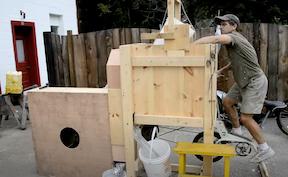
Do you need to thresh, clean, and dehull a small plot of oats, emmer, einkorn, or dry beans? Free plans are available to build your own bicycle-powered thresher, fanning mill, and dehuller/flour mill. They also include instructions on how to build a pto for a bike to run the machines. A Sustainable Ag Research and Education (SARE) grant supported the Grain Bikes Project, which was completed in 2016. All plans are available from SARE and on the Farm Hacks website.
The plans at both sites provide detailed information and images. On the sites, Jan Yoder, project leader, offers extensive commentary about the machines, their development, and their use. The quotes below are selected from his various commentaries.
The Grain Bikes Project resulted from the need of several small farmers in Massachusetts to process bean and grain crops. One of them paid half the cost of prototyping. Yoder described the option for most as threshing out and sorting dry beans at about 3 lbs. per hr. and restoring antique fanning mills to clean small grains. Small-quantity dehullers for rice and other hulled grains were simply not available.
The project produced prototypes, videos, and detailed plans. The machines cost around $600 partly because they were repurposed from discarded bikes and exercycles. The bikes provided bearings, transmissions, and gears; wood was used for most other parts.
Initially, Yoder planned to move a bike from one tool to another. He quickly discovered that with free bikes, building the bike into each tool made more sense.
Another change came early with the dehuller/flour mill. Yoder started modifying a flour mill and ended up designing and building his own mill with dehulling pads made from silicone caulk. His design accommodates commercial steel or stone burrs for flour milling. He also provided instructions for making crude steel burrs with an angle grinder to grind flour.
“The dehuller is adjustable for different sizes of grains and how hard the grains are abraded during dehulling,” says Yoder. “The original prototype pads were expensive rubber glued to the two substrate disks. First, we found one rubber disk rubbing against one abrasive disk worked better than two. Then we found that cheap, universally available silicone caulk makes a better rubber disk at one-tenth the cost.”
The prototypes proved the machines’ abilities and defined their limitations. The thresher processed 1/2 lb. to 1 lb. per min. of rice, wheat, and most beans.
With its two screens, blower, and shaker, the fanning mill exceeded 1 lb. per min. for all crops and 5 to 10 lbs. per min. for most grains. Yoder noted that some crops require multiple passes. He found that rice required a pass before dehulling and a second pass after.
In addition to the plans, Yoder and company also made videos of each machine in operation and an introductory video.
Contact: FARM SHOW Followup, SARE (https://projects.sare.org/project-reports/one16-277/) or FARM HACK (https://farmhack.org/tools/bicycle-powered-thresherfan-mill-and-dehuller).
